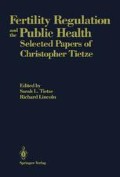Abstract
The primary objective of this report is to evaluate the demographic effects of induced abortion on human fertility, defined in terms of the number of children born per 1000 women over a specified period. Physicians, on the other hand, define fertility as a woman’s capacity to produce offspring during her reproductive life. To avoid the confusion that this semantic difference has sometimes created, the reader must be aware that throughout this paper, the term fertility is used in its demographic sense—as numbers of live births and live birth rates for selected populations and periods.
Access this chapter
Tax calculation will be finalised at checkout
Purchases are for personal use only
Preview
Unable to display preview. Download preview PDF.
References
Berger GS, Tietze C, Pakter J, Katz SH. Maternal mortality associated with legal abortion in New York State: July 1, 1970-June 30, 1972. Obstet Gynecol 1974;43:315.
Hungary: Demographic Research Institute. The concealment of induced abortions: an estimate of induced abortions. Survey Techniques in Fertility and Family Research: Experience in Hungary. Budapest: Central Statistical Office, 1969, pp. 110–118.
International Planned Parenthood Federation Europe Region. Legal Abortion in Britain. London: International Planned Parenthood Federation Europe Region, 1973.
Muramatsu M. An analysis of factors in fertility control in Japan. Bull Inst Public Health 1970; 19:97.
Peller S. Fehlgeburt und Bevölkerungsfrage. Stuttgart: Hippokrates-Verlag, 1930, p. 184.
Puffer RP, Griffith GW. Patterns of Urban Mortality. Washington, DC: Pan American Health Organization, 1967, pp. 290, 314.
Requeña M. Condiciones determinantes del aborto inducido. Rev Med Chile 1966;94:714.
Robbins J. Unmet needs in family planning: a world survey. Family Planning Perspectives 1973;5:232.
Serenko AF. Abort kak sotsial’nogigienichskaya problema. In: Serenko AF, ed. Prepodavanie Sotsial’noy gigiyeny i Organizatsii Zdravookhraneniya v Medit-sinskikh Institutakh. Moscow: I.M. Sechenov Medical Institute, 1969, pp. 34–35.
Tietze C. Two years’ experience with a liberal abortion law: its impact on fertility trends in New York City. Family Planning Perspectives 1973;5:36.
Tietze C, Bongaarts J. Fertility rates and abortion rates: simulations of family limitations. Studies in Family Planning 1975;6:114.
Centers for Disease Control. Abortion Surveillance 1974. Atlanta, Georgia: Centers for Disease Control, 1976.
United States: National Center for Health Statistics. Vital Statistics of the United States. Vol. II. Mortality. Published annuOnliney. Also Summary Report. Final Mortality Statistics. Part II. Cause of Death. Published annuOnliney as supplements to Monthly Vital Statistics Report.
Weinstock E, Tietze C, Jaffe F, Dryfoos J. Abortion need and services in the United States: 1974, 1975. Family Planning Perspectives 1976;8:58.
World Health Organization. Spontaneous and Induced Abortion. Technical Report Series No. 461. Geneva: WHO, 1970.
Editor information
Editors and Affiliations
Rights and permissions
Copyright information
© 1987 Sarah L. Tietze
About this chapter
Cite this chapter
Bongaarts, J. (1987). The Demographic Effect of Induced Abortion. In: Tietze, S.L., Lincoln, R. (eds) Fertility Regulation and the Public Health. Springer, New York, NY. https://doi.org/10.1007/978-1-4612-4702-9_35
Download citation
DOI: https://doi.org/10.1007/978-1-4612-4702-9_35
Publisher Name: Springer, New York, NY
Print ISBN: 978-1-4612-9121-3
Online ISBN: 978-1-4612-4702-9
eBook Packages: Springer Book Archive

